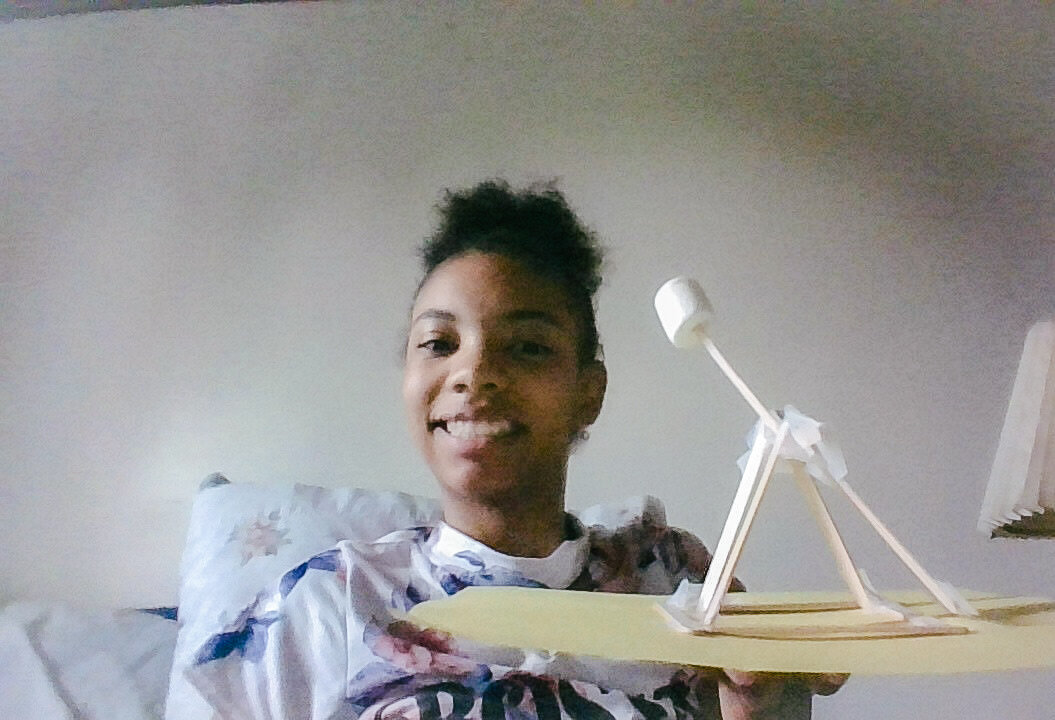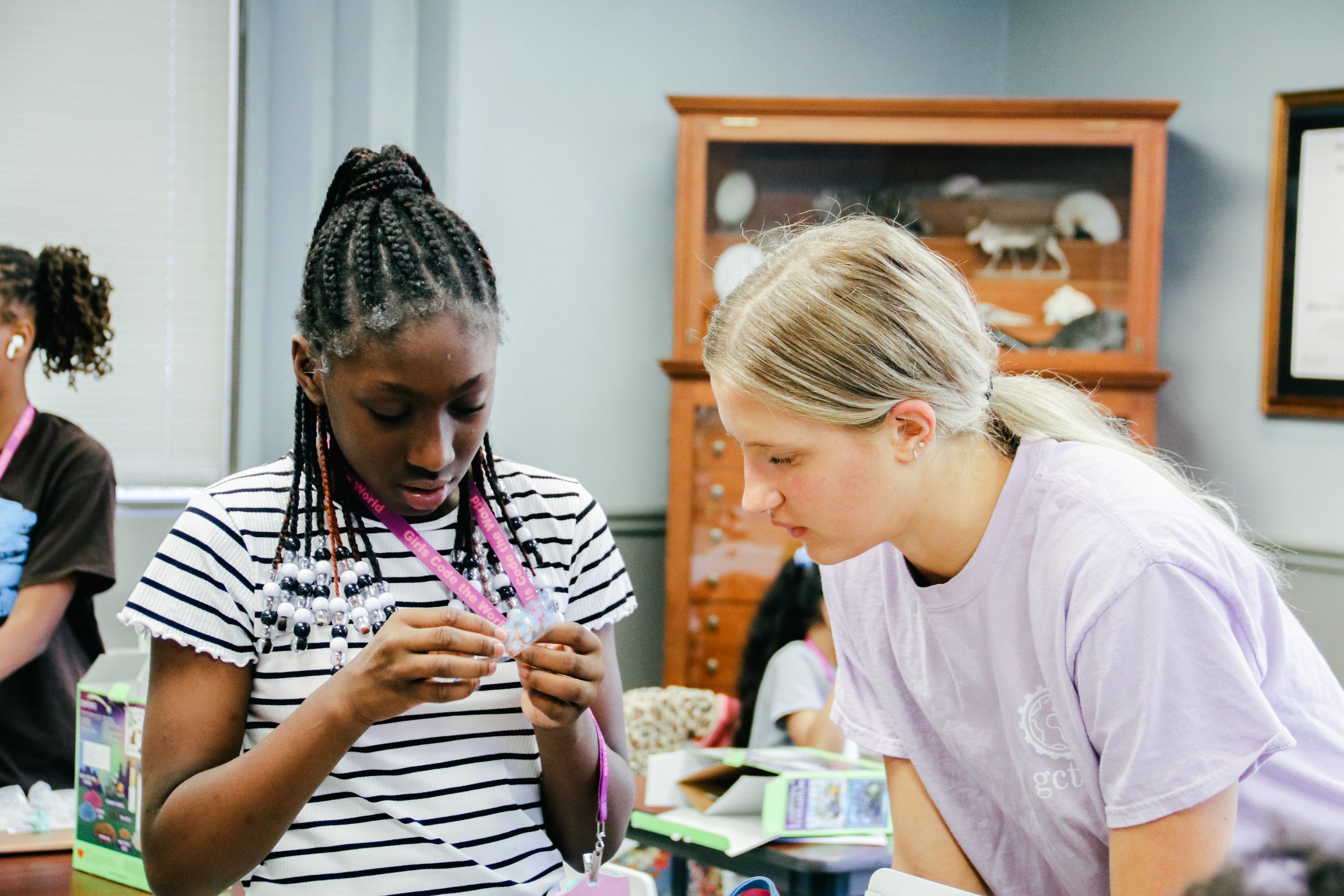Curriculum and Program Overview
Girls Code the World has hosted a variety of programming since 2018. We work with individual schools, youth organizations, and larger education districts.
Our Curriculum
Although our name is “Girls Code the World”, our programming focuses on the intersection between life sciences, engineering, coding, technology, and computer science. We emphasize the importance of the design engineering process, introduce girls to careers/opportunities in STEM, and inspire them to be leaders in the field by bringing in female speakers. We do hands-on projects, laptop-based lessons, and teamwork activities. Some of our lessons include 3D printing, a water filtration system, building a dancing project using drag and drop block-based coding, and learning about aerodynamics.
Specialized Lessons
We also create specialized and research-based curriculum for schools by collaborating with their STEM teachers on lesson plans that prepare girls to be confident in their classes. We have worked with one school five years in a row now, constantly improving the program every year to match their specific needs.
Scope and Sequence Method
We use a Scope and Sequence planning method to create lesson plans. This method allows us to visualize the progression of thought and understanding of our participants. All of our Lesson Plans begin with a Warm-Up that engages the minds of the girls, and all Lesson Plans end with a conclusion that encourages the girls to make real world connections and create tangible understandings.
Our Teaching Theory
According to research, girls perform better when they are surrounded by those like them in their classes and when they have role models that they seem themselves in. Girls Code the World applies this method and by having diverse female teachers, speakers, and participants.
What We Offer at Our Programs
Our in-person and virtual program focuses on holistic STEM education, reaching across many different fields such as engineering, coding, biology, and chemistry. Girls Code the World facilitates an appreciation for the wide application of STEM and fosters a growth mindset.
Virtual Programming
Girls Code the World runs virtual programming by sending girls a MakerBox: a box that contains all of the necessary materials for activities. Programming is a mixture of live Zoom sessions and independent tutorials. Pictured on the left is one of our participants displaying her Introduction to Engineering Lesson final product on Zoom.
Certifications
Our Scope and Sequence Method has been reviewed by Information Sciences and Technology professors, certified instructional designers, and academic teaching excellence institutes. It has been made in collaboration with middle school STEM teachers to match their school’s resources.
Coding Platforms
We work specifically with drag and drop block-based programs such as Scratch and Code.org. The girls also become familiar with Java through Hello World! and Biology with Processing.
Example Lessons
-
The purpose of this lesson is to empower students with a practical understanding of water filtration by engaging them in the hands-on assembly of filtration kits. Through this experiential learning, students will grasp the fundamental principles behind water purification, developing a deeper appreciation for the importance of clean water. Ultimately, the lesson aims to instill a sense of environmental responsibility as students recognize their role in ensuring access to safe and clean water for communities around the world.
-
The purpose of this lesson is to introduce students to the fascinating world of circuits and electricity through the creation of bristlebot mini vibrobots. By actively assembling these small robots, students will gain hands-on experience in constructing simple circuits and understanding the principles of electrical flow. This lesson aims to spark curiosity and excitement about STEM subjects, laying the foundation for future exploration and comprehension of more complex electronic concepts.
-
The purpose of this lesson is to immerse students in the field of biomechanics and prosthetics by challenging them to construct a mechanical grabber using simple materials like popsicle sticks and straws. Through this hands-on activity, students will explore the engineering principles behind functional movement and the design considerations essential for creating assistive devices. The lesson aims to inspire a deeper understanding of biomechanics, fostering creativity and empathy as students engage with the potential applications of their grabber in the context of prosthetics.
-
The purpose of this lesson is to empower students with the essential skills of coding through Scratch.mit.edu, focusing on variables and functions. By delving into drag-and-drop coding, students will grasp the fundamentals of creating a password generator, fostering an understanding of the importance of strong passwords for online security. Through this engaging activity, students will develop a practical application of their coding knowledge, ultimately contributing to the broader goal of enhancing internet safety and cybersecurity awareness in their community.
The leaders that have reviewed our curriculum and impact surveys
Provided curriculum insights:
Dr. Amy Garbrick, Director of the Office of Learning Design, College of Information Sciences and Technology at Penn State University
Director of the Office of Learning Design, College of Information Sciences and Technology at Penn State University
B.S. in Education from Penn State University
M.Ed. in Instructional Systems (INSYS) from Penn State University
Ph.D. in Learning, Design, and Technology (LDT) from Penn State University
Kristen L. Aballa, Middle School Teacher, Christina Seix Academy
Middle School Teacher, Christina Seix Academy
Bachelor’s Degree in Elementary Education from Penn State University
Master’s Degree in Literacy from Wilmington University
Dr. Larkin Hood, Instructional Development Consultant at the Schreyer Insitute for Teaching Excellence | Associate Research Professor
Instructional Development Consultant at the Schreyer Insitute for Teaching Excellence | Associate Research Professor
B.A. in English Language and Literature from the University of Michigan
M.A. and Ph.D. in Anthropology from the University of Washington
Dr. Deena Levy, Technology Pedagogy Specialist and Instructional Consultant at the Schreyer Insitute for Teaching Excellence | Associate Research Professor
Technology Pedagogy Specialist and Instructional Consultant at the Schreyer Insitute for Teaching Excellence | Associate Research Professor
B.A. in English from Rutgers University
M.A. and Ph.D. in Italian from Rutgers University
M.Ed. in Learning, Design, and Technology from Penn State University
Provided research & survey insights:
Dr. Sarah Zappe, Research Professor and Educational Psychologist at Penn State University
Research Professor and Educational Psychologist at Penn State University
Director of Assessment and Instructional Support in the Leonhard Center for the Enhancement of Engineering Education
Dr. Lee Erickson, Chief Amplifier at Happy Valley LaunchBox
Chief Amplifier at Happy Valley LaunchBox
B.A. in Education from Virginia Tech University
M.A. in Educational Communications and Technology from New York University
Ph.D. in Crowdsourcing and Innovation from Penn State University









